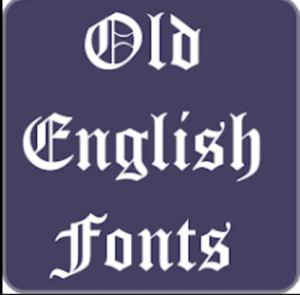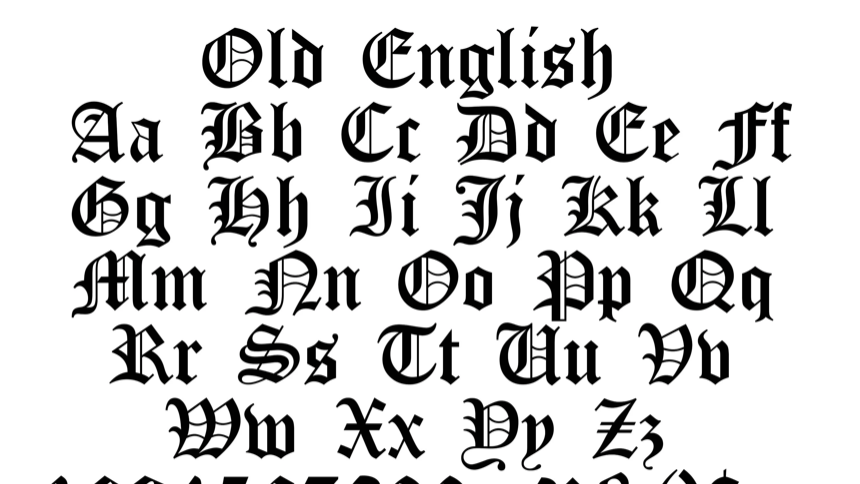Old English fonts have a distinct charm that transports us to a bygone era. These typefaces, also known as blackletter fonts, originated in the Middle Ages and were predominantly used in handwritten manuscripts and inscriptions. Today, they continue to captivate designers and enthusiasts alike with their ornate and intricate letterforms.
Old English fonts are characterized by their elaborate and intertwined letters, which often resemble calligraphic strokes. They exude a sense of regality and sophistication, making them a popular choice for projects that require a touch of vintage elegance. Whether you’re designing a logo, creating print materials, or even getting a tattoo, understanding the history and characteristics of Old English fonts is essential for choosing the perfect typeface.

old English Fonts
History and characteristics of Old English fonts
The origins of Old English fonts can be traced back to the 12th century when they emerged as a script style for writing manuscripts in Western Europe. These fonts were heavily influenced by Gothic architecture and the intricate patterns found in illuminated manuscripts. The script gained popularity in England during the late medieval period, hence the name “Old English.”
One of the defining characteristics of Old English fonts is their angular and sharp letterforms. They are often bold and heavy, with sharp serifs and ornate details. The letters are typically closer together, creating a compact and dense appearance. This unique style of lettering adds a sense of drama and grandeur to any design.
Popular Old English fonts for different design purposes
When it comes to choosing the perfect Old English font for your project, there are several options to consider. Each font has its own distinct personality and can evoke different emotions and moods. Here are some popular Old English fonts and their recommended design purposes:
1. Blackletter Typeface: This classic Old English font is characterized by its intricate and ornate letterforms. It is an ideal choice for formal and elegant designs such as wedding invitations, certificates, and high-end branding.
2. Fraktur Typeface: Fraktur fonts have a more angular and Gothic appearance. They are often associated with vintage or antique designs and can add a touch of nostalgia to your project. Use Fraktur fonts for book covers, posters, and historical-themed designs.
3. Textura Typeface: Textura fonts have a dense and compact appearance, with letters closely connected to each other. These fonts are perfect for creating a dramatic and mystical atmosphere. Use Textura fonts for gothic-inspired designs, album covers, and dark fantasy themes.
Tips for pairing Old English fonts with other typefaces
Pairing Old English fonts with other typefaces can be a challenging task. It requires careful consideration of the overall aesthetic and readability of the design. Here are some tips to help you successfully pair Old English fonts with other typefaces:
1. Contrast Styles: To create visual interest, pair an Old English font with a contrasting style such as a modern sans-serif or a sleek serif font. The contrast between the ornate Old English font and a simpler typeface can create a harmonious balance.
2. Consider Legibility: Old English fonts can be intricate and sometimes difficult to read, especially in smaller sizes. Be mindful of the legibility and readability of the design, especially if the text is meant to convey important information.
3. Balance and Hierarchy: Use Old English fonts sparingly and strategically to create emphasis and hierarchy within your design. Combine them with simpler fonts to create a clear visual hierarchy and guide the viewer’s eye.
Using Old English fonts in logo design
Old English fonts are a popular choice for logo design as they exude an air of tradition and authenticity. They can add a sense of heritage and prestige to a brand identity. When using Old English fonts in logo design, consider the following:
1. Brand Personality: Ensure that the Old English font aligns with the personality and values of the brand. For example, a luxury brand may opt for a more ornate and elaborate Old English font, while a vintage-inspired brand may choose a distressed or weathered style.
2. Readability: While Old English fonts can add visual interest to a logo, it’s important to ensure that the text remains legible. Avoid using overly complex or decorative letterforms that may compromise readability.
3. Simplify and Modernize: Old English fonts can be quite intricate, which may not translate well in digital formats or when scaled down. Consider simplifying and modernizing the font to ensure it remains versatile and adaptable across different mediums.
Incorporating Old English fonts into print materials
Old English fonts can elevate the design of print materials, adding a touch of elegance and sophistication. Here are some ways to incorporate Old English fonts into your print materials:
1. Headings and Titles: Use Old English fonts for headings and titles to create a focal point and draw attention to important information. The ornate letterforms of Old English fonts can instantly grab the viewer’s attention.
2. Invitations and Stationery: Old English fonts are a popular choice for formal invitations and stationery. Whether it’s a wedding invitation or a business card, Old English fonts can add a touch of grandeur and sophistication.
3. Poster and Flyer Design: Old English fonts can give your posters and flyers a vintage or retro vibe. They are particularly effective for event promotions, such as concerts, art exhibitions, or historical-themed events.
Old English fonts in digital design and website typography
In the digital age, Old English fonts have found their place in website typography and digital design. Here are some tips for using Old English fonts effectively in digital design:
1. Readability and Responsiveness: Ensure that the Old English font you choose is readable on different screen sizes and resolutions. Consider using a web-safe font or embedding the font to maintain consistency across different devices.
2. Use as Accent Text: Instead of using Old English fonts for large blocks of text, consider using them as accent text or for headings. This will maintain readability while still adding a touch of vintage elegance to your design.
3. Pair with Modern Fonts: To create a contemporary and visually appealing design, pair Old English fonts with modern and clean fonts. The contrast between the two styles can create a striking visual impact.
Old English fonts in tattoo design and lettering
Old English fonts have long been associated with tattoo design and lettering. Their bold and ornate letterforms make them a popular choice for creating impactful and visually striking tattoos. Here are some considerations when using Old English fonts in tattoo design:
1. Size and Placement: Old English fonts tend to be intricate and detailed, so it’s important to choose an appropriate size for the tattoo. Consider the placement on the body to ensure that the design remains legible and visually appealing.
2. Customize and Personalize: Add your own creative touch to the Old English font by customizing and personalizing it. Incorporate additional elements, such as flourishes or decorative motifs, to make the design unique and meaningful.
3. Consult a Professional: If you’re not confident in your ability to design or execute the tattoo, it’s always best to consult a professional tattoo artist. They can provide guidance and ensure that the design translates well onto the skin.
Resources for finding and downloading Old English fonts
Finding the perfect Old English font for your project can be a daunting task. Fortunately, there are numerous resources available online that offer a wide selection of fonts. Here are some popular websites where you can find and download Old English fonts:
1. Google Fonts: Google Fonts offers a variety of free and open-source fonts, including several Old English options. Simply search for “Old English” in the font library to explore the available options.
2. Font Squirrel: Font Squirrel is a popular resource for free and commercial fonts. They have a dedicated section for Old English fonts, allowing you to browse and download fonts that suit your design needs.
3. DaFont: DaFont is a well-known platform for free fonts. They have a vast collection of Old English fonts, often submitted by independent designers. Remember to check the licensing restrictions before using the fonts for commercial purposes.
Conclusion: Embracing the timeless elegance of Old English fonts
Old English fonts continue to captivate designers and enthusiasts with their timeless elegance and intricate letterforms. Whether you’re designing a logo, creating print materials, or even getting a tattoo, understanding the history, characteristics, and best practices of using Old English fonts is crucial.
By following the tips and considerations outlined in this guide, you can confidently choose the perfect Old English font for your project. Remember to explore various resources to find the font that best suits your design needs. Embrace the beauty and charm of Old English fonts, and let them transport your designs to a bygone era of elegance and grandeur.
CTA: Discover the stunning world of Old English fonts and unlock their timeless elegance for your next design project. Browse our extensive collection of Old English fonts and find the perfect typeface to bring your vision to life.

